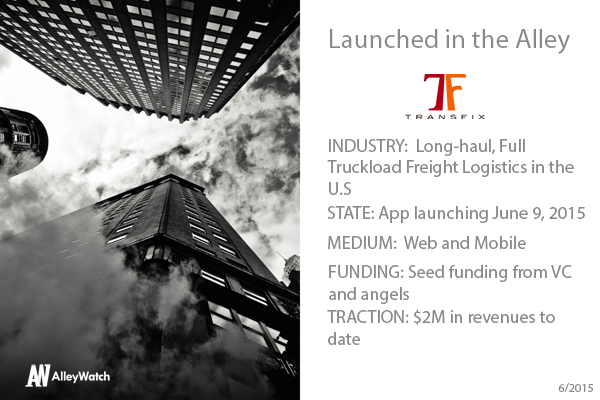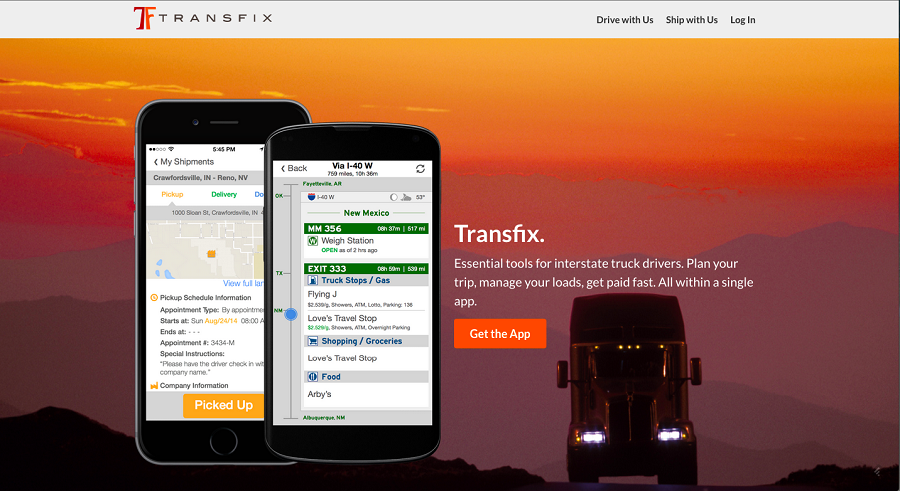Transfix is an on-demand freight logistics marketplace and technology solutions company with a smartphone app that matches shipments with drivers, and with features that help truckers every step along the road. They (unanimously) won the Transportation Startup Challenge – which was a big green light for the company. Some serious investors are also already on board, including LererHippeau Ventures, Founder Collective, Bowery Capital, Deep Fork Capital, Corigin Ventures, Expansion Venture Capital and Thayer Street Partners. Now they’re launching their proprietary mobile app for interstate drivers and cofounder and CTO Jonathan Salama explains his company’s win-win that aim is to cut gross inefficiencies, and to improve profitability and work satisfaction for independent owner-operators and small carriers in this 60+ year old, $700 billion industry that needed a major overhaul like Transfix.
Tell us about the service.
Transfix is a B2B marketplace for shipping full truckloads, and a provider of mobile and web tools to truck drivers, trucking companies, and shippers.
How is it different?
Of all the long-haul full truckload (FTL) startups looking to disrupt traditional brokerage, Transfix alone can claim the following:
- Founded by a 2nd generation industry veteran with recognized expertise in freight logistics and supply chain.
- A tech team lead by some of the very top engineers in the country, recognized for building Gilt Groupe from the ground up, one of the most successful startups in digital and mobile history.
- A company dedicated to helping independent owner-operators and small carriers eradicate the status quo and compete with legacy giants. We also pay our drivers very fast.
What market are you attacking and how big is it?
We are attacking traditional freight brokerage. The total size of the trucking market is $700 billion. The total size of the freight brokerage market is $80 billion.
What is the business model?
The primary business model is a technology-driven freight marketplace where Transfix’s gross margin is the difference between the ‘buy’ price and ‘sell’ price in a given lane (route).
There is also a secondary SaaS product, where shipping customers pay a transaction fee to utilize our transportation management system (TMS) for real-time tracking and management of their own in-house fleets and freight.
How did winning the Six Minute Pitch Contest help your business?
Participating in the Transportation Research Board’s (TRB) Six Minute Pitch was an invaluable experience. Winning by unanimous vote – that was icing on the cake; it felt great to have leading industry experts reaffirm what we knew in our gut, that our business model could deliver far-reaching, win-win impacts. We were very grateful.
Through winning the contest, we developed some valuable industry relationships, and were acknowledged by A-list tech and biz journalists. We also received multiple national and international invitations to speak and present.

That said, we focus the majority of our time on developing our products and on building strong relationships with our drivers, carriers and shippers. This is to say, we won the competition, and went right back to work.
You’ve received some funding. Who were your investors, how much did you raise, and how did that help you to, ok, keep on trucking?
Transfix has raised ~$2.5 million in capital to date. Investors include LererHippeau Ventures, Founder Collective, Bowery Capital, Deep Fork Capital, Corigin Ventures, Expansion Venture Capital and Thayer Street Partners. Our Angels consist of Paul Sethi, Ben Narasin, Carter Reum and Michael Bryzek.
What are the milestones that you plan to achieve within six months?
Our plan for the next six months is to continue doing more of what we’re doing now: scaling our shipper, driver and carrier base while continuing to roll out our new features roadmap. We can’t go into too much detail, but we have some aggressive short-term milestones ahead.
If you could be put in touch with one (more) investor in the New York community who would it be and why?
We feel fortunate to have the amazing group of investors we have now. If we were looking to grow our list, it would be with a firm that believes in us for all the right reasons.
…Elon Musk. He’s not exactly an NYC resident, but his mom lives in Manhattan, if that counts. I’d imagine Tesla would be interested in improving the efficiency of freight shipping.
You also track phases of the moon and, out of curiosity, how do the phases of the moon affect the trucking industry (besides the obvious, of course – that the werewolves are out)?
We built our feature roadmap based on our regular surveys and conversations with our drivers. We want to build what they tell us they want and need. Moon phases, as bizarre or random as it may seem, are regularly tracked by many of our drivers. They prefer to drive at night to avoid as much traffic as possible. But not all truck routes are well lit, and the amount of natural light really makes a marked difference. On nights they know it will be pitch black, many opt to drive during the day.
Some of our truck drivers also swear that there’s some credibility to the old wives tale of people acting crazier than usual during a full moon. Some of our drivers stay on high alert, driving with even greater caution at that time to avoid the potential uptick in reckless motorists.
Why did you launch in New York?
Launching in NYC mattered mainly from a talent and investor perspective. Drew McElroy (Co-founder and CEO) and I knew we could build the stellar, solid team we were after through our connections in NYC better and faster than if we were based anywhere else. Since NYC was already “home” for both of us, it was an easy choice.
What’s your favorite outdoor bar in NYC, when you need to make a pitstop?
My wife and I work long days. We live in Brooklyn, so we typically keep it close to home. Bar San Miguel has great outdoor ambiance. Killer margaritas, Mexican food and a laid-back, rustic atmosphere.





